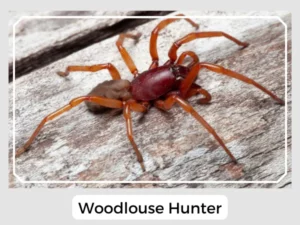Guess what? There’s a spider called the woodlouse spider because it loves eating woodlice! It comes from places near the Mediterranean Sea. This cool spider doesn’t make webs; instead, it hunts for its food. We’ve got fun facts about it right here.
An average of 70 eggs are laid in an egg cocoon that is made from a few silk strands.
After the hatching, the young spiders remain dependent on their mothers until they attain maturity which comes after 1 to 1.5 years.
Yes, Woodlouse Spiders are venomous. They use their venom to catch their favorite food, woodlice.
Yes, Woodlouse Spiders can bite. While they usually focus on hunting for food, they might bite if they feel scared or cornered. But don’t worry too much; their bite isn’t too bad for most people.
The woodlouse spider plays a vital role in controlling the population of woodlice and other small invertebrates, acting as a natural pest control agent. This not only helps in maintaining ecological balance but also aids in reducing the reliance on chemical pesticides, contributing to a healthier environment.
Natural Predators and Prey-Predator Dynamics: While the woodlouse spider is a predator in its own right, it is not without natural threats. Birds, larger spiders, and other predators prey on them, establishing a balanced prey-predator dynamic in their habitats. This balance is crucial for the stability of the ecosystem, ensuring that no single species dominates to the detriment of others.
Relationship with Humans: Generally, woodlouse spiders are beneficial to humans, as they help control the population of woodlice and other pests. They are not aggressive towards humans and only bite when provoked. Educating people about their role and importance can foster a harmonious coexistence and appreciation for these spiders.
| Also Known as | Pillbug hunter, slater spider, sowbug killer, sowbug hunter, woodlouse hunter |
| Distribution | New Zealand, Australia, certain regions of South and North America, and South Africa |
| Habitat | Bricks, rocks, underneath logs, and a heap of leaves |
| Diet | Primarily woodlice, earwigs, millipedes, and silverfish |
| Lifespan | 3-4 years |
| IUCN Conservation Status | Not listed |
In conclusion, the woodlouse spider is a remarkable species with fascinating hunting habits, a unique diet, and significant ecological importance.

Guess what? There’s a spider called the woodlouse spider because it loves eating woodlice! It comes from places near the Mediterranean Sea. This cool spider doesn’t make webs; instead, it hunts for its food. We’ve got fun facts about it right here.
An average of 70 eggs are laid in an egg cocoon that is made from a few silk strands.
After the hatching, the young spiders remain dependent on their mothers until they attain maturity which comes after 1 to 1.5 years.
Yes, Woodlouse Spiders are venomous. They use their venom to catch their favorite food, woodlice.
Yes, Woodlouse Spiders can bite. While they usually focus on hunting for food, they might bite if they feel scared or cornered. But don’t worry too much; their bite isn’t too bad for most people.
The woodlouse spider plays a vital role in controlling the population of woodlice and other small invertebrates, acting as a natural pest control agent. This not only helps in maintaining ecological balance but also aids in reducing the reliance on chemical pesticides, contributing to a healthier environment.
Natural Predators and Prey-Predator Dynamics: While the woodlouse spider is a predator in its own right, it is not without natural threats. Birds, larger spiders, and other predators prey on them, establishing a balanced prey-predator dynamic in their habitats. This balance is crucial for the stability of the ecosystem, ensuring that no single species dominates to the detriment of others.
Relationship with Humans: Generally, woodlouse spiders are beneficial to humans, as they help control the population of woodlice and other pests. They are not aggressive towards humans and only bite when provoked. Educating people about their role and importance can foster a harmonious coexistence and appreciation for these spiders.
| Also Known as | Pillbug hunter, slater spider, sowbug killer, sowbug hunter, woodlouse hunter |
| Distribution | New Zealand, Australia, certain regions of South and North America, and South Africa |
| Habitat | Bricks, rocks, underneath logs, and a heap of leaves |
| Diet | Primarily woodlice, earwigs, millipedes, and silverfish |
| Lifespan | 3-4 years |
| IUCN Conservation Status | Not listed |
In conclusion, the woodlouse spider is a remarkable species with fascinating hunting habits, a unique diet, and significant ecological importance.
